
































by Will Nicholls
We often see social media posts calling for boycotts of American products these days. A lot of these posts are from Crees. That’s understandable, as US President Donald Trump’s threatened 25% tariffs will hurt all Canadians economically. But the subsequent trade war, as Canada imposes retaliatory tariffs on American goods, could be especially felt by Indigenous Peoples across Canada.
Some remote First Nations already pay up to $16 for a toothbrush, for an example of how expenses are already high. More importantly, food insecurity will be become an even greater concern as many of our groceries come from the US. Prime Minister Justin Trudeau has already pointedly mentioned that Florida oranges will be targeted.
That’s just north of the border. In the US itself, the Freeze Latino Movement is already stepping up efforts for boycotts with social media videos in response to mass deportations of people of Hispanic descent. The videos are a way of asking people not to spend money on American corporations. On their website, they state, “We can all collectively make a
big impact by simply holding and not spending our money.”
The following are companies targeted in its boycott:
• Coca-Cola
• Walmart
• McDonald’s
• Starbucks
• Costco
• Subway
• Pizza Hut
• Home Depot
• Tesla
• KFC
• Domino’s
If you wish to join the boycott, those are some products to target. Or, when you are shopping, simply look at the label and see where the item is produced.
Crees already spoke in the last Quebec referendum about their wishes and can continue to do so. As Benjamin Franklin famously said when his newborn country was facing a much larger, more powerful adversary, “We must all hang together or assuredly we shall all hang separately.”
Let’s all just hope that this longtime trading partner and ally stops trying to make us enemies rather the close friends we have historically been.






The Nation is published every two weeks by
OF FINANCES

Danielle Valade THANKS TO: Air Creebec




CONTRIBUTING WRITERS X. Kataquapit, P. Quinn, P. Quinn, N. Fedosieieva, D. Kelly-Menard DESIGN
CONTACT US: The Nation News, 918-4200 St. Laurent, Montreal, QC., H2W 2R2
EDITORIAL & ADS: Tel.: 514-272-3077, Fax: 514-278-9914 HEAD OFFICE: P.O. Box 151, Chisasibi, QC. J0M 1E0 www.nationnews.ca EDITORIAL: will@nationnews.ca news@nationnews.ca ADS: Danielle Valade: ads@nationnews.ca; Donna Malthouse: donna@beesum.com
SUBSCRIPTIONS: $60 plus taxes, US: $90, Abroad: $110, Payable to beesum communications,
of: The James Bay Cree Communications Society, Circle Of Aboriginal
Hebdos Sélect Du Québec. Funded [in part] by the Government of Canada. | www.nationnews.ca |




After discovery of unmarked graves at the Kamloops Indian Residential School in British Columbia in 2021, the federal government allocated over $200 million to support initiatives aimed at documenting deaths and commemorating the children who did not return home. However, recent reports indicate a substantial reduction in this funding.


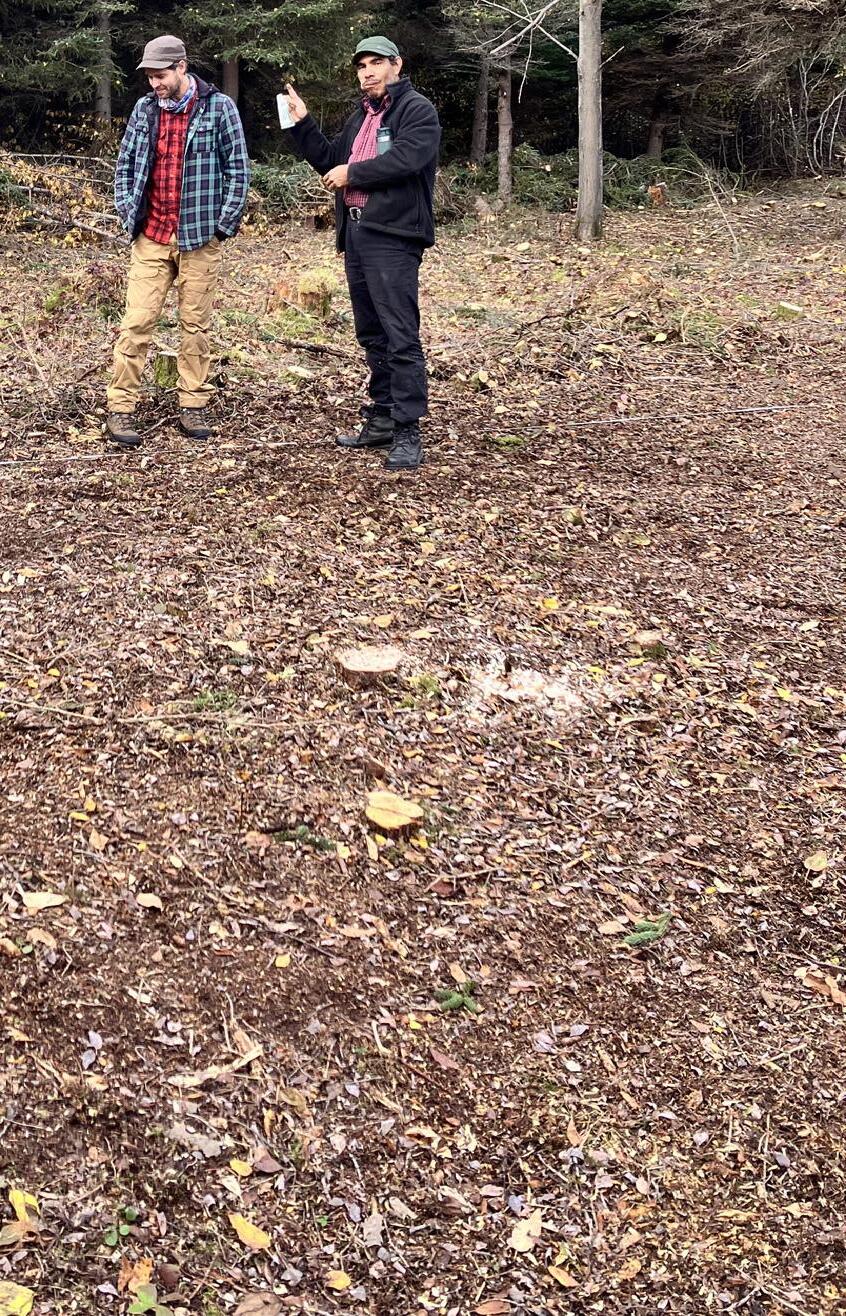
Kimberly Murray, the Independent Special Interlocutor for Missing Children and Unmarked Graves, told the Nation a few months ago that the initial funding, which averaged about $71 million annually, has been cut to $45.5 million per year.
Continuing the investigative process is essential for healing, accountability, and for the protection of future generations, says George Pachano, Residential School Research Project Manager for the Grand Council of the Crees. Since 2022, Pachano has coordinated the search of unmarked graves at the Fort George Roman Catholic residential school near Chisasibi.
His preliminary investigations were based on stories from people who had gone to residential schools, then visiting a few locations mentioned in those stories with the trained dogs that stopped and identified that something was there.
“The first couple of years, it was basically trying to get information and attending a few gatherings just to get information on what we needed,” Pachano said. “In the ground, underground, where bodies have been buried, even long periods, say 100 years, they can still pick it out.”
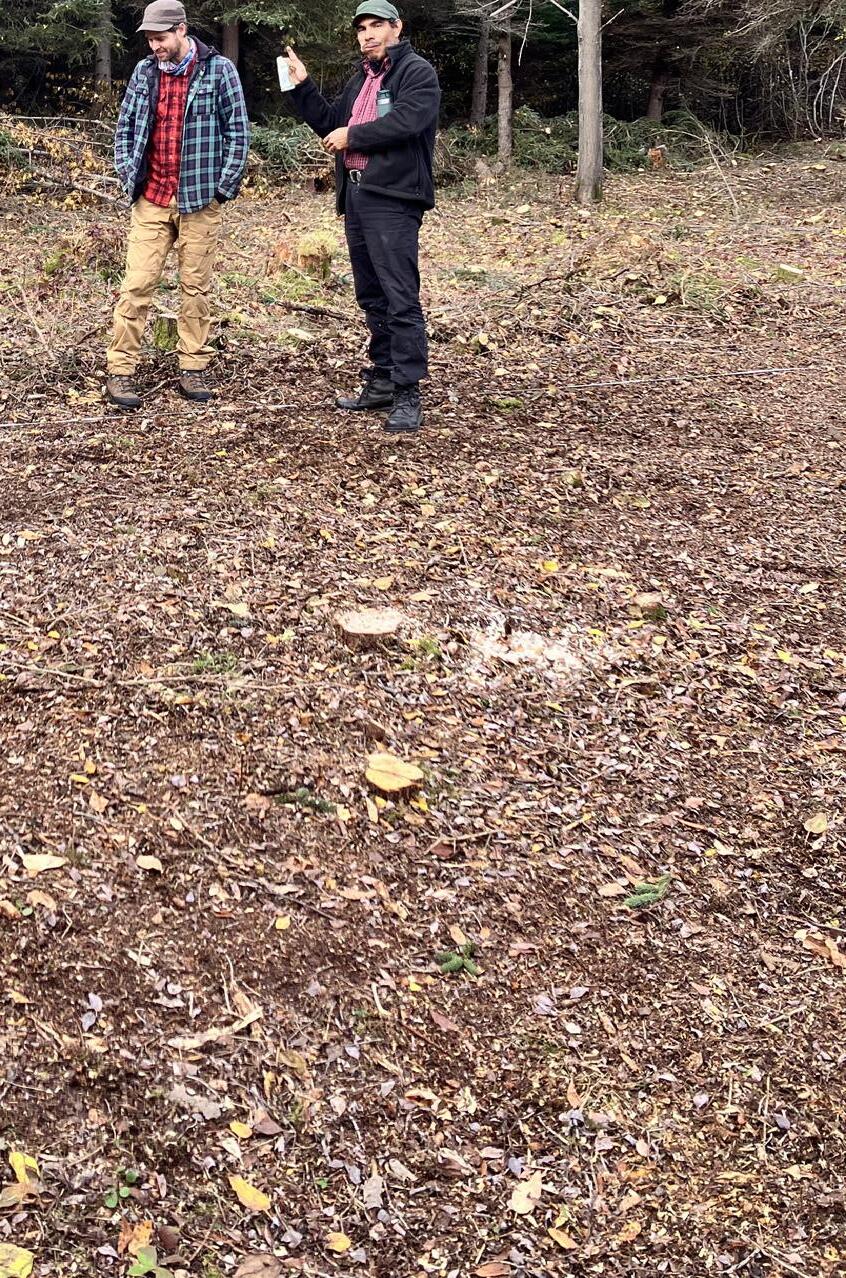

Pachano and his team obtained ground penetrating radar (GPR) equipment from the Université de Montréal. However, as “there was a lot of overgrowth in that area, where the school stood, we had to clear and cut all that, for that team to come in, so they can do their job.”
by Natalia Fedosieieva

According to Crown-Indigenous Relations Canada, all funding decisions under Budget 2024 aimed to provide money to as many communities as possible with a focus on continuing the progress of current projects.

An April 2024 report stated, “they don’t find bodies, they find anomalies,” and “there are areas that definitely need further investigation.”
Pachano said it does require further investigation with a S4 machine, similar to GPR, to analyze the results with the sound waves and high accuracy. He believes he can continue his research with the money left, but “there’s not very much and we still have to do some clear cutting as there’s still a lot of overgrowth.”
This project could take two or three more years, but he said the team needs to hire an archivist. “We need people to do the work, but we cannot hire a full-time researcher now because of the uncertainty of the funds.”
Pachano thinks national or provincial organizations like Assembly of First Nations and Indigenous leaders should lobby governments for more funding.
“Funding has to continue,” he said. “We can’t just leave it like that, because it’s important for people who went to residential schools, for the parents who lost their children. And siblings, they need to know where their brothers and sisters are.
“This has to be settled before we move on. For me, anyway,” he added.
“The Government of Canada has not made any funding cuts to the Residential Schools Missing Children Community Support Fund,” said Pascal Laplante, a spokesperson for Crown-Indigenous Relations Canada, in an email to the Nation
Since 2019, Ottawa has provided $417.6 million to support Indigenous-led projects which responds to the Calls to Action 72 to 76 of the Truth and Reconciliation Commission report, he added.
“The funding was extended to provide an additional $91 million over two years, starting in 2024-25,” he said. “Funding decisions have been provided for 2024-25 fiscal year initiatives only, the deadline for 2025-26 funding applications is September 15, 2025.”
Laplante believes this is difficult but important work and there is a need for the federal government to take appropriate measures to support communities in searching for and commemorating missing children at former residential school sites.
“Under the residential school system, some Indigenous children were lost and some died,” he wrote. “Acknowledging that fact – and taking concrete actions to address these wrongs – is essential to our shared path towards reconciliation.”


Long before European contact, customary adoption was common among the Cree and other Indigenous people. It traditionally involved placing a child with another family for survival purposes when the parents were for some reason unable to properly care for them.
After lobbying by Cree authorities since the early 1980s to legally recognize this practice, Quebec began consulting with Indigenous groups in the early 2000s when it was reviewing its own adoption laws. With Bill 113 passed in 2017, the province’s Indigenous Nations now have the ability to create their own unique systems that oversee and document this process.

As the provincially designated “competent authority” in Eeyou Istchee, the Cree Nation Government is working with communities to establish local committees and reaching out to families who may be interested in the certification process. This would give families the option of adoption or guardianship without the involvement of courts, lawyers or government officials.
“We’re trying to redevelop a custom, not to enforce it upon a community,” said CNG regional coordinator James Bobbish. “We’ve discussed with the health board and other organizations to help develop all this and we’ve just finalized it within the last few months. The next steps will be to reach out to the communities to ask how many people are actually interested in pursuing customary adoption.”
A former leader of the Cree Health Board, Bobbish has been working on this initiative since 2007. Now working under the CNG’s social and cultural department, Bobbish has coordinated with Joanne Ottereyes in the communications department to develop the necessary documents and consulted with legal counsel to ensure requirements are met.
“We are changing somebody’s status, so the file has to be held in a very secure and confidential manner,” Bobbish told the Nation. “It’s very important that the people who do live with the child have parental
authority whenever it’s needed. It clarifies for medical or school issues.”
Recognition as primary caregivers enables adoptive parents to give consent for the child’s medical care, enrol them in schools or extracurricular programs, sign passport applications and manage their bank accounts. It also ensures childcare benefits are being appropriately directed.
Customary adoption is a consensual and collective process that often keeps a child within the community or with extended family so biological parents may maintain a relationship. Growing up around people who know their culture, language and spiritual practices helps to nurture a child’s feelings of security, belonging and identity.
Once the two families have consented to transfer parental authority and submit the application, they will sit with the local committee to reach a formal agreement. Then the justice system conducts background checks of all adults in the household to ensure the child isn’t being put at risk.
“We’ll come to an arrangement that is suitable for everybody,” said Bobbish. “If there’s anything out of the ordinary, it’s up to the families if they want to continue or not. It could be a certain uncle was caught drunk driving five years ago, but he’s cleaned up his act so the family determines it’s not going to be an issue.”
When Bill 113 was unveiled, the CNG and other Indigenous stakeholders requested amendments to recognize customary guardianship, which involves placing a child with another family tem-
porarily until a situation is resolved. This can now be certified according to the same process and then reversed when that phase has passed.
“We never determine how long this temporary adoption will be,” Bobbish explained. “During that period, the people actually living with the child have parental authority. It’s all based on how the local parents decide.”
Additional reference checks may be necessary in some cases and a child in youth protection may require the director’s recommendation to determine where lies their best interest. With greater self-determination in childcare, the CNG hopes to avoid further children falling through the system’s cracks.
“At one point there were three children seeing a parent in Montreal and got called on by youth protection services down there,” recalled Bobbish. “The two older ones were sent back to the community and the youngest who was a baby was put into an adoption bank – when it was dealt with seriously, it could not be turned back.”
As customary adoption isn’t legally recognized in most provinces, Cree members in MoCreebec, Ontario aren’t eligible for the program. For the CNG to support certification processes, the adoptive parents must reside in Quebec and at least one parent must be Cree. If two Indigenous Nations are involved, both groups must sit together to decide which system they will use.
“There are Inuit children living with people in Chisasibi, so we need to make an arrangement with the Inuit,” said Bobbish, who said he’s waiting to hear
by Patrick Quinn, Local Journalism Initiative Reporter
back from them. “It’s usually the system where the child comes from so the community has a hand in their movement.”
Mixed culture arrangements can quickly get complicated. Jaaji Okpik spent summers with his Mohawk father when he was growing up and the rest of the year with his adopted family, his maternal Inuit grandparents. His healthcare card had a different identity than his passport.
While it’s unclear how many families throughout Eeyou Istchee may already be practicing customary adoption, about one in six children born every year in Nunavik end up in customary adoption.
So far, five communities have formed a local committee and one has already designated members. Each will require training before getting into a case. Committees may include advisors, such as Elders and knowledge holders, who are familiar with ancestral adoption practices.
Cree families will continue to have the option of going through Quebec’s formal adoption process. The present Call for Interest intends to assess necessary resources and connect interested persons with Bobbish, then eventually the local committees.
“I’m really looking forward to once one of the customary adoption processes is done,” said Bobbish. “When there’s an adoption within the regular courts, there’s usually a feast around the family. I would imagine some kind of ceremony will develop to signify the child is officially with these people.”
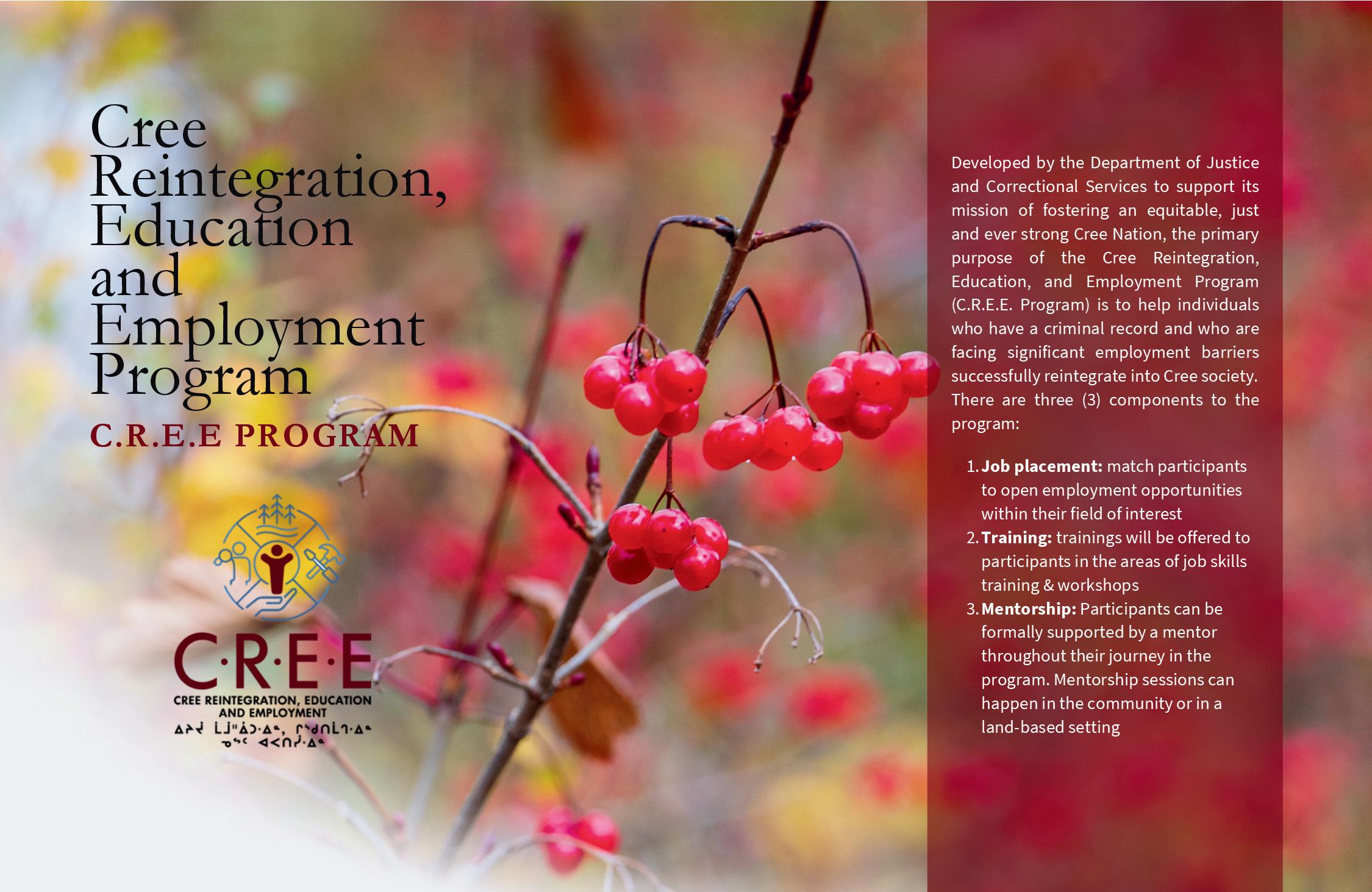

On February 25, Francis Verreault-Paul was elected the new regional chief of the Assembly of First Nations for Quebec and Labrador. For the past two years, the 37-yearold had served as chief of staff to now-former regional chief Ghislain Picard, who announced in January he would not seek re-election after serving for 33 years.
“I commit to be a unifying voice, to listen, to act and to carry our claims forward with conviction,” said VerreaultPaul. “Issues and priorities will be defined in consultation with all Chiefs, to ensure that the interests and needs of each community are fully taken into account.”
Coming from the Innu community of Mashteuiatsh in Quebec’s Lac-Saint-Jean region, Verreault-Paul is a former hockey star with McGill University who went on to play professionally in the U.S. and Europe until 2020.
The Cree Nation welcomed Verreault-Paul’s focus on renewal in facing challenges with “humility and determination” while paying respects to Picard’s legacy. Picard was congratulated for his “unwavering support” for improving the quality of life of First Nations peoples over 11 consecutive terms.
“While his departure from the political landscape will be felt by many, his steadfast leadership and his many accomplishments throughout the decades will always stand as his legacy,” stated the Grand Council of the Crees.
Picard announced his intentions in a letter to the organization’s 43 Chiefs in December, stating, “I firmly believe that
the AFNQL has succeeded in meeting the challenge of making our issues more visible, in an environment that too easily tends to bypass our priorities.”
Among the 36 Chiefs who participated, Verreault-Paul received 58% of the vote, beating out candidates Atikamekw Grand Chief Constant Awashish; Cathy Martin, a council member of the Listuguj Mi’kmaq government; and Monik Kistabish, Chief of the Abitibiwinni First Nation.
“I’m ready for the challenge,” asserted VerreaultPaul. “I’ve always thought about running in politics. Ghislain did an amazing job for this and I want to pursue that in the same way.”
The North’s biggest grocery store chain is being accused in a class-action lawsuit of misusing millions of dollars in federal subsidy money that was supposed to be entirely passed on to consumers.
A statement of claim filed in Manitoba called the company “predatory” for not passing on to consumers all funds from the Nutrition North program started in 2011 to help residents in 125 northern communities. The plaintiffs are former Nunavut commissioner Nellie Kusugak, film producer Malaya Qaunirq
Chapman and cultural educator Isabelle Chapadeau.
North West Company’s retail locations include 188 Northern stores and five NorthMart stores.
The company’s roots go back to the fur trade and the Hudson’s Bay Company. A group of investors, including hundreds of employees, bought the HBC’s Northern Stores Division in 1987, renaming its outlets three years later.
Since the federal government began the program in 2011, it has paid out more than $1.2 billion in subsidies. A 2023 study found that only 67% of the subsidy was being passed on to consumers, a figure dropping to 53% in communities where the Winnipeg-based company has a monopoly.
With many northern communities not having year-round road, rail or marine access, the subsidy is intended to make perishable and nutritious foods more accessible and affordable. Lawyers said the lawsuit aims to get compensation for Northerners and to put pressure on the federal government to improve the Nutrition North program.
A spokesperson for North West Company denied the allegations, stating it has passed all audits ensuring that 100% of funds are passed along. They added that the Nutrition North program “on its own, is not enough,” with “substantial cost drivers in the North due to the lack of infrastructure, the high
cost of materials and operations, and inflation.”
Two individuals in Waskaganish were hospitalized and a third was monitored by CMC clinic staff after consuming a blue pill that has been sent for analysis by the Eeyou Eenou Police Force (EEPF). The drug is stamped “Red Bull” on one side with an image of a bull on the other.
Waskaganish EEPF officers alongside provincial police executed a search warrant February 21, seizing 430 white pills marked “ICE”, alleged to be a methamphetamine. An additional 52.1 grams in cocaine and some marijuana was also seized, along with $8,385 in Canadian currency and various drug paraphernalia.
Two male individuals, one female and an underage female were arrested for possession of a controlled substance with the intent to traffic. They were released with promises to appear in court.
“The Eeyou Eenou Police Force would like to formally express its appreciation to the public for their invaluable contributions to the effort of addressing drug-related challenges in our communities,” stated the Cree police detachment.
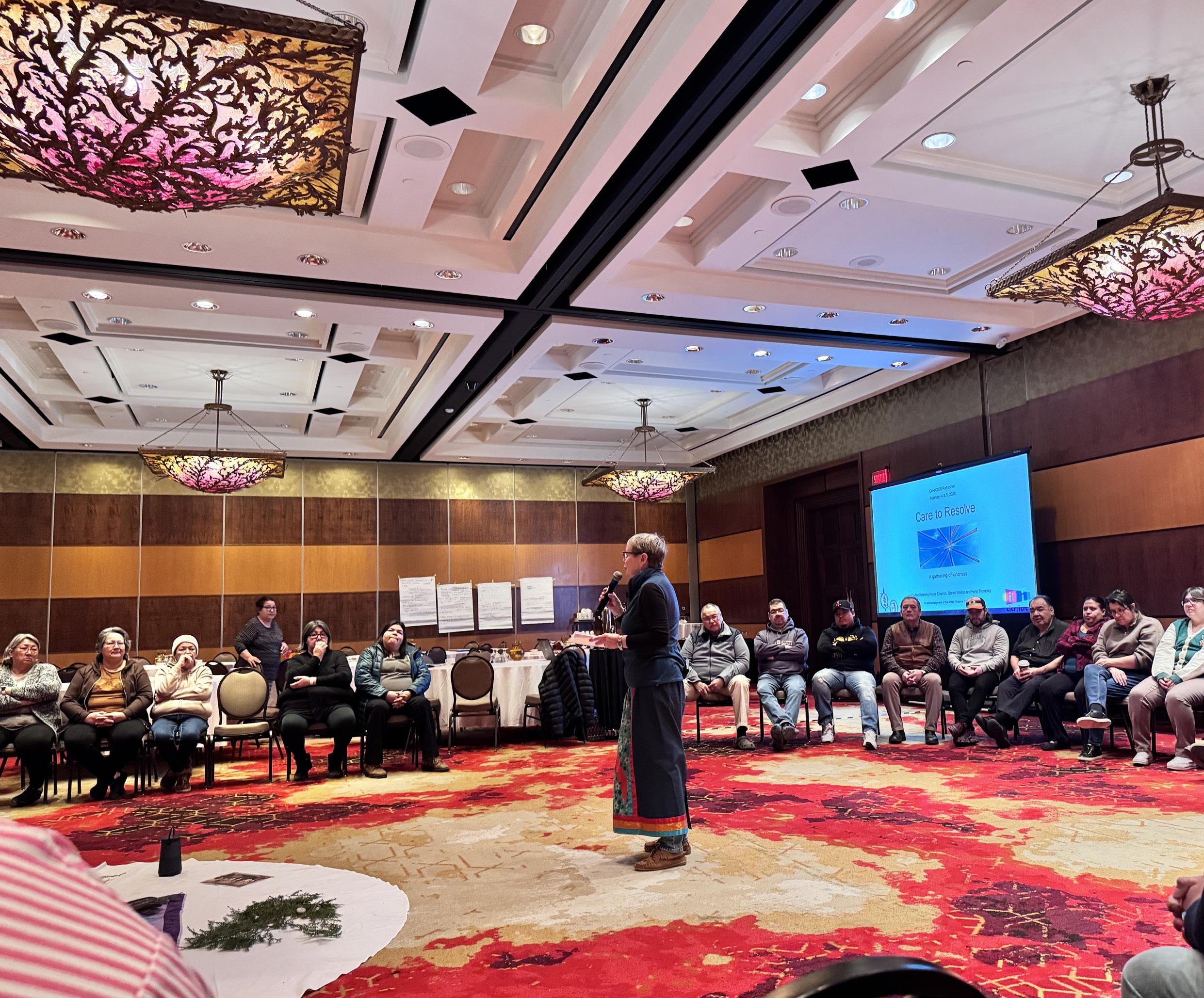



by Patrick Quinn, Local Journalism Initiative Reporter
by Patrick Quinn, Local Journalism Initiative Reporter
he Cree Nation partnered with Ontario fire departments on January 31 to launch a Fire Prevention Officer (FPO) Mentorship Program in Orillia, Ontario. With 10 FPOs from Cree communities working for a month in conjunction with 11 fire departments across Ontario, the program is the first of its kind in Canada.
“Fire prevention is so vital for our communities, especially with the unique challenges we face,” stated Cree Grand Chief Mandy Gull-Masty. “This mentorship program will give our Fire Prevention Officers the knowledge and support needed to better protect our communities and build a safer future for all in Eeyou Istchee.”
The Cree Nation faces similar high fire risks as do other First Nations, including overcrowded housing and socioeconomic inequities. A 2021 report found children living on a reserve in Ontario are 86 times more likely to die in a fire than those living elsewhere.
Arecent gala for Justice Department staff in Gatineau kicked off this year’s commemorations for the 50th anniversary of the James Bay and Northern Quebec Agreement.
The most common causes of residential fires are lit smoking materials, unsupervised youth playing with lighters or matches, accidents during cooking, faulty wiring or overloaded circuits, and combustibles like clothing or furniture being too close to heating sources.
Fire prevention in Eeyou Istchee is overseen by the CNG’s capital works and services department, comprised of the fire marshal, fire prevention officer and fire protection administrator. When George Cox became regional FPO in 2014, he started implementing the fire prevention bylaw and coordinating with communities to hire local FPOs.

Grand Chief Mandy Gull-Masty and Deputy Grand Chief Norman Wapachee gave motivational speeches about the JBNQA’s transformative impact and how the next 50 years might look. Promotional hats, mugs, journals and a cake honoured Canada’s first modern treaty.
“Each one talked about both the good and the bad that has come with it,” said Donald Nicholls, Director of Justice and Correctional Services. “How resilient we have been in keeping things core to us that make us a distinct people. We thought we’d start the momentum – there will be more celebrations throughout the year.”
Last spring, Cox was working on a Fire Master Plan with Waswanay Consulting, touring Cree communities to gather information about potential risk issues. While FPOs were certified during their training program, it was determined they lacked mentorship opportunities once they returned to their communities.
The Justice Department also celebrated its 15-year collaboration with the Canadian Institute of Conflict Resolution with a two-day refresher course for staff and a presentation by CICR executive director Daniel Markus. Over 200 Cree people have completed this free 160-hour training program, including the Grand Chief and several other leaders.
“The court system doesn’t resolve conflict within the communities in a holistic way, so we decided to create a course built upon Cree values,” explained Nicholls. “We wanted to empower people, so conflicts don’t have to escalate to courts or arbitration.”
Recognizing the language barrier in Quebec, Waswanay reached out to Ontario fire departments about organizing a mentorship program. They received a positive response from 11 municipal departments both large and small, from mid-size cities like Kingston, Kitchener and Windsor to smaller communities like Kawartha Lakes and Rama First Nation.
“We want them to be immersed in fire prevention, fire inspections and public education programs,” explained Cox. “I think the program is very exciting for our Cree Nation. We’ll benefit from other professionals who have been in fire prevention for over 20 or 30 years.”
Leading up to the official anniversary on November 11, the Cree Nation has launched a website – JBNQA50.com – with an animated video series called “United We Walk” that revisits the treaty’s context, process and outcomes. The second of nine videos was recently released, titled “Only Beavers Can Build Dams.”
Among other outcomes, Cree FPOs are expected to learn how early detection systems are established, data collection and collaboration for investigations, coordination of public education programs, budget management, evacuation plan reviews, and identifying hazards in both residential and commercial visits.
During the partnership’s first two years, CICR trainers learned about Cree values and realities. They designed a culturally centred approach to help resolve conflicts between individuals likely to have frequent encounters. Managers of Cree entities routinely do a four-week program, learning mediation and dialogue-facilitation skills that improve relationships in both the workplace and personal life.
“We have Cree trainers we call peacemakers who are learning from CICR so eventually we could do it all in Cree if we want,” said Nicholls.
“We just finished graduating a group from Apatisiiwin Skills Development to help frontline communication, understanding underlying reasons why people may be frustrated or anxious.”
About 80 people from nine Cree communities, along with Montreal and Val-d’Or, attended the gala. Live music accompanied a feast and games while employees Edna Neeposh Jr., Rachel Mattawashish and Marlene Bearskin were honoured for their 10th year of service. Retiring employees Sarah Ottereyes and Anna Neeposh were given a plaque and present.
The department is adding around 30 employees this year as its tiny home initiative is implemented in the four largest Cree communities. Transitional spaces that aid reintegration into community life will open in Mistissini and Waskaganish this spring, then this autumn in Waswanipi and Chisasibi.
“Coming to a tiny home community, you sign a contract that you’ll abide by the violence-free rules there and you’ll participate in all the programming,” Nicholls told the Nation “In provincial systems, they get no rehabilitation to help them through substance use or anger management issues they may be experiencing.”
The initiative responds to government reports acknowledging inadequate programming for people being released from detention facilities, recommending that communities develop solutions. The DOCJS took the lead with the tiny home project.
Each micro community of 10 tiny homes equipped with essential amenities will be arranged in a circle around a main building that will host transitional services, a kitchen, dining area, two meeting rooms and a workshop space.
The DOJCS and Cree Health Board will designate a nurse and a social worker for each planned community. They also hope to partner with Apatisiiwin to provide skills training and career counsellors.
“We want to create a positive environment for people who want to make a change,”
Nicholls said. “It’s taken longer to build than we thought. If we work with people and reduce recidivism, increase community safety and restore some of the harm that was committed, that’s the ultimate goal.”
When the DOJCS was established in 2008, a survey was conducted among all the Cree in the system to analyze root causes of incarceration as well as their skills, needs and aspirations. As most surveyed preferred to work with their hands, Nicholls suggested carpentry and similar vocational programs be introduced in tiny home communities.
Land-based programming will be integral to each project, having proven effective in fostering healthier relationships and

deepening connections to the culture. Elders often join DOCJS excursions to the bush and visits to Cree people in provincial prisons, offering guidance and sometimes even cooking traditional food.
Noting that the DOCJS has limited power to support Cree people in the provincial system, Nicholls would like to build halfway houses as an intermediate step for those who have been released from prison but aren’t yet ready for tiny homes. However, this requires staff with the appropriate psychology or social worker degrees.
Some tiny homes have been designated as spaces to address the region’s growing homelessness issue. The DOCJS is currently working with five communities to develop shelter solutions, such as transitional residences. It raises the question of who should be operating these facilities and determining acceptance criteria.
“It’s not any one group that should be responsible,” asserted Nicholls. “All of us need to come together to deal with the underlying causes of homelessness and provide the support necessary for people to transform themselves from that situation to a healthier one.”

February 21, 2025 — Funding provided by the Impact Assessment Agency of Canada (IAAC) is now available to help Indigenous Peoples and the public participate in the impact assessment process for the proposed Shaakichiuwaanaan Mining Project, a new open-pit and underground lithium mine located east of Radisson, Quebec.
Funding is available for eligible individuals and groups to support their participation throughout the planning phase of the federal impact assessment process. During the current comment period, which ends on March 16, 2025, Indigenous Peoples and the public are invited to review the summary of the Initial Project Description and provide comments. IAAC will retroactively reimburse eligible participants for their participation in this first comment period.
Applications received by March 24, 2025, will be considered.
For more information about the Participant Funding Program, including eligibility criteria and the application form, please visit the project home page on the Registry website, reference number 89271, and click on “Participant Funding.” You can also contact the Participant Funding Program by writing to fp-paf@iaac-aeic.gc.ca or by calling 1-866-582-1884. Details about the project can also be found on the project home page.
Stay updated on this project by following IAAC on X: @IAAC_AEIC #Shaakichiuwaanaan
For media inquiries, contact IAAC’s media relations team by writing to media@iaac-aeic.gc.ca or calling 343-549-3870.
Achieve your entrepreneurial dream through mentorship!
Niimuudaan helps you find mentors who can support you through their compassionate listening and experience sharing.
Let's celebrate the women... in our families, in our communities, in our world!
Contact us!
WEB | CREENATION-AT.COM/EN/NIIMUUDAAN TEL | (819) 824-9888 EXT: 1



ARE YOU A SURVIVOR OF FORCED OR COERCED STERILIZATION OR DO YOU KNOW SOMEONE WHO IS?
You are not alone. The Survivors Circle for Reproductive Justice has launched a national Healing Fund to provide healing support funds to First Nations, Inuit and Metis survivors.

Up to $10,000 for individual healing Up to $30,000 for Assisted Reproductive Technology Survivors Up to $30,000 for community projects led by survivors First Nations/Organizations/Groups

George M. Shecapio from Mistissini is a well-known figure throughout Eeyou Istchee. If you ever attend a hunters’ meeting or anything related to the use of the land, the role of tallymen or the future of Cree hunting, Shecapio will likely be in the crowd. You may also see him explaining the role of the Cree Hunters Economic Security Program at one of the public meetings in any of the 10 Cree communities.
At least, you could see him until now because Shecapio, at 68 years old, is retiring. After more than 34 years working for what was once the Cree Hunters and Trappers Income Security Program, now renamed the Cree Hunters Economic Security Program, he is returning to his roots – going back to the bush.
Shecapio knows the Program well. Indeed, when it first started in 1976, he was already in the bush. Starting in December 1975, he would go to the bush after Christmas, only to come out in the spring. At the time, he recalls, families left for a long time.
“There were three bush planes at that time in Mistissini, carrying families to the bush,” he recounted. “Most people would go from September all the way to June. A few family members would come out in December, usually only for a couple days to pick up supplies. Then they would head back and only come out in June, well after ice breakup and Goose Break. All traplines were occupied back then and some traplines had up to five families living there, sharing the land.”
When asked about how he got involved with the Income Security Program, Shecapio recalls vividly.
“I was already in the bush in 1975, and I remember enrolling on the Program in the summer of 1976. I also remember my first payment in the amount $1,440, a cheque given to me by
the late Peter Shecapio, who was the Local Administrator for the Program at the time. I got to know Peter very well over the years, as it would be him who I would meet for interviews and to get my cheques.”
Shecapio continued in the bush until 1979. He then trained to become a carpenter, working as one for a short time. However, the lure of the bush was strong, and he went back in 1981. By 1982, he was back on the Income Security Program.
“I got back on the Program for five years, starting again in 1982 all the way to 1987,” he explained. “Then in 1987, I was asked to work as a General Manager for the Louis-Joliette outfitting operation on our family’s trapline, trapline M-35. Then one day, I ran into Peter Shecapio who told me he had been promoted to Program Assistant – Services, and that he would need someone to replace him as Local Administrator. Peter made it clear that I should apply for the job, insisting how I would enjoy working for the Cree hunters of Mistissini.
Shecapio said he debated long and hard about whether to take the job, but several people urged him to.
“One of my good friends, Matthew Coon-Come, told me, ‘I’m sure you can be of service to the people because of your skills.’ My father, the late Matthew Shecapio, also told me, ‘You know the needs of the trappers very well by now.’ So, I took my pen and wrote my resume on a piece of paper, as well as a cover letter. I sent it to Peter and I was hired!”
Shecapio was Local Administrator for the community of Mistissini for 15 years. Then, in 2009, he was promoted to Program Assistant – Services, after the retirement of the late Peter Shecapio. Now in 2025, George has worked for over 34 years for the hunters, an admirable feat in today’s world.
When asked what he will miss the most about his job, Shecapio responded with no hesitation.
“I will miss the people I work for, the hunters, and the people I work with, my colleagues,” he said. “I really enjoy meeting the hunters and trappers all over Eeyou Istchee, hearing their stories, listening to their concerns and trying to help them as best I can.”
As for the hard times, Shecapio replied candidly, “The job was always fun, but over the years, I lost several colleagues like Peter Shecapio, Jacob Gull and Allen Neacappo – aka ‘General’, with whom I had been working with a long time. During my time on the job, we also lost Jean-Baptiste Loon and Willie Longchap, who were not only Local Administrators in Mistissini, but friends as well.”
As for his retirement plans, Shecapio simply stated, “Go to the bush!”
Then he added, “I will keep helping my community when they need me, but I plan to spend as much time in the bush as possible. My main trapline is M-35, at the mouth of the Rupert River on Lake Mistassini, but I also have a camp near Mistissini, where I expect to spend time with family and friends when I am not deep in the bush.’’
Shecapio also has already been called for duty on various committees in Mistissini.
“Mistissini Chief Michael Petawabano asked me to join the CTA local committee, and I was asked to sit on the Elders’ council. I accepted without hesitation as I see this as an opportunity to keep helping Cree hunters and Elders out on the land.”
Helping hunters out on the land –definitely a life mission for George M. Shecapio.
by Serge Larivière

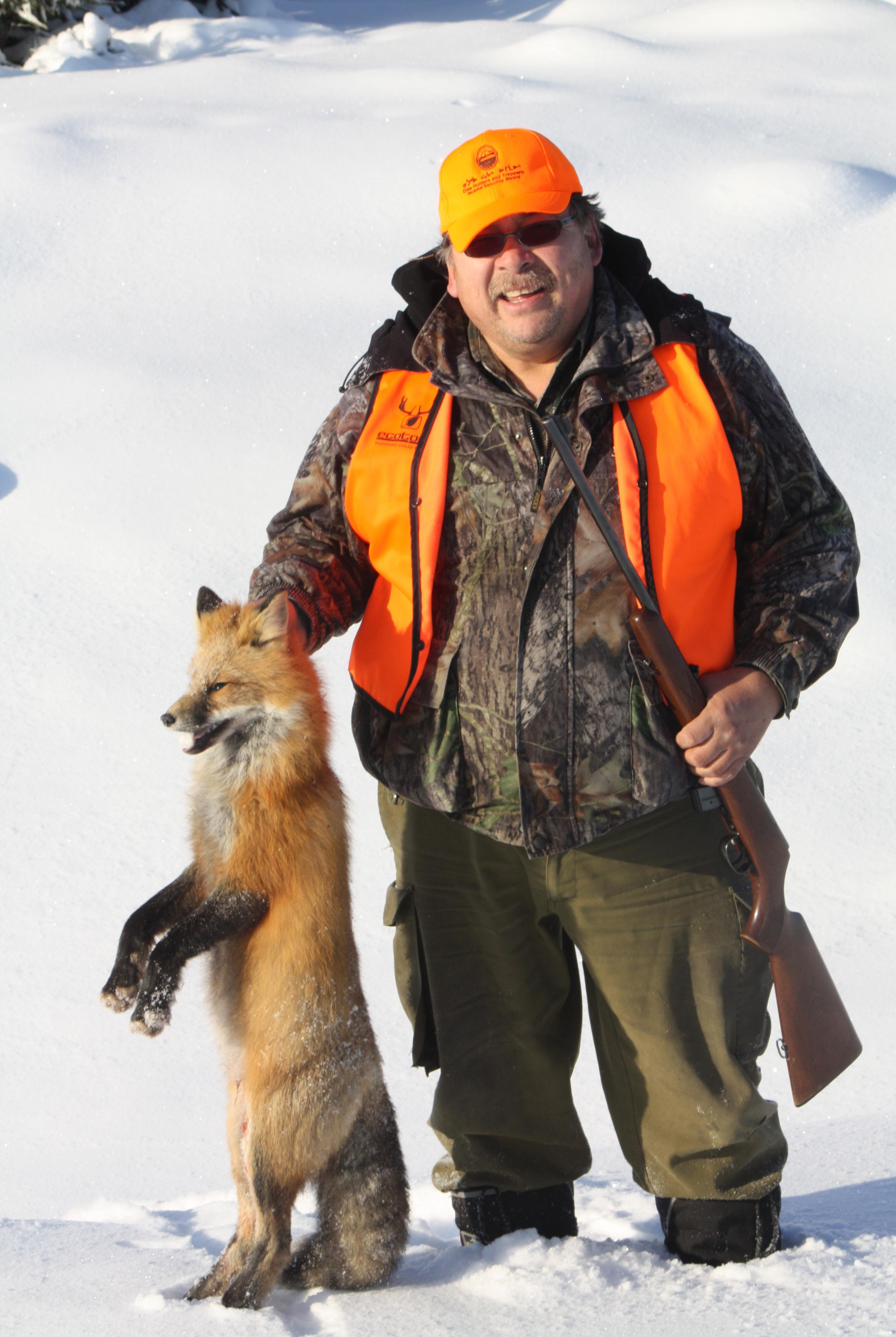


WEAR WATERPROOF BOOTS with removable liners to keep feet dry. Cold weather can be harsh on your feet, especially if you have diabetes or reduced circulation. Keep them safe with these quick tips:

KEEP YOUR FEET WARM AND DRY prefer wool socks over cotton and change them if damp.
CHECK YOUR FEET for any sores, blisters, or cuts. WEAR PALE SOCKS it will help you see any stain from possible wound. WARM UP SAFELY keep your feet away from direct heat sources, like open fires, electrical heaters, or hot water bottles. ENJOY WINTER SAFELY Protect your feet and stay active!




TITLE: CONSTRUCTION DIRECTOR
TITLE: CONSTRUCTION DIRECTOR
TITLE: CONSTRUCTION DIRECTOR
TITLE: CONSTRUCTION DIRECTOR
TITLE: CONSTRUCTION DIRECTOR
LOCATION: LAVAL
LOCATION: LAVAL
LOCATION: LAVAL
LOCATION: LAVAL
LOCATION: LAVAL
You are a construction leader ready to take on significant challenges and contribute to large-scale projects? We are looking for a strategic Construction Director to lead our projects in a dynamic and fast-growing environment, particularly in Baie-James, on First Nations territory. This role will allow you to be involved in the planning, execution, and delivery of projects, whileintegrating best practices in cost, schedule, and quality management. You are a pragmatic leader with a strategic mindset and a drive to move projects forward, we look forward to meeting you!
You are a construction leader ready to take on significant challenges and contribute to large-scale projects? We are looking for a strategic Construction Director to lead our projects in a dynamic and fast-growing environment, particularly in Baie-James, on First Nations territory. This role will allow you to be involved in the planning, execution, and delivery of projects, whileintegrating best practices in cost, schedule, and quality management. You are a pragmatic leader with a strategic mindset and a drive to move projects forward, we look forward to meeting you!
You are a construction leader ready to take on significant challenges and contribute to large-scale projects? We are looking for a strategic Construction Director to lead our projects in a dynamic and fast-growing environment, particularly in Baie-James, on First Nations territory. This role will allow you to be involved in the planning, execution, and delivery of projects, whileintegrating best practices in cost, schedule, and quality management. You are a pragmatic leader with a strategic mindset and a drive to move projects forward, we look forward to meeting you!
You are a construction leader ready to take on significant challenges and contribute to large-scale projects? We are looking for a strategic Construction Director to lead our projects in a dynamic and fast-growing environment, particularly in Baie-James, on First Nations territory. This role will allow you to be involved in the planning, execution, and delivery of projects, whileintegrating best practices in cost, schedule, and quality management. You are a pragmatic leader with a strategic mindset and a drive to move projects forward, we look forward to meeting you!
You are a construction leader ready to take on significant challenges and contribute to large-scale projects? We are looking for a strategic Construction Director to lead our projects in a dynamic and fast-growing environment, particularly in Baie-James, on First Nations territory. This role will allow you to be involved in the planning, execution, and delivery of projects, whileintegrating best practices in cost, schedule, and quality management. You are a pragmatic leader with a strategic mindset and a drive to move projects forward, we look forward to meeting you!
Implement the construction strategy in alignment with the Company’s vision.
Implement the construction strategy in alignment with the Company’s vision.
Implement the construction strategy in alignment with the Company’s vision.
Implement the construction strategy in alignment with the Company’s vision.
Implement the construction strategy in alignment with the Company’s vision.
Collaborate with your team to manage projects going from planning to delivery, optimizing costs, schedules, and quality.
Collaborate with your team to manage projects going from planning to delivery, optimizing costs, schedules, and quality.
Collaborate with your team to manage projects going from planning to delivery, optimizing costs, schedules, and quality.
Collaborate with your team to manage projects going from planning to delivery, optimizing costs, schedules, and quality.
Collaborate with your team to manage projects going from planning to delivery, optimizing costs, schedules, and quality.
Develop and monitor budgets, identifying optimization opportunities in collaboration with Project Managers.
Develop and monitor budgets, identifying optimization opportunities in collaboration with Project Managers.
Develop and monitor budgets, identifying optimization opportunities in collaboration with Project Managers.
Develop and monitor budgets, identifying optimization opportunities in collaboration with Project Managers.
Develop and monitor budgets, identifying optimization opportunities in collaboration with Project Managers.
Supervise Project Managers and provide guidance to teams within your department.
Supervise Project Managers and provide guidance to teams within your department.
Supervise Project Managers and provide guidance to teams within your department.
Supervise Project Managers and provide guidance to teams within your department.
Supervise Project Managers and provide guidance to teams within your department.
Maintain a safe work environment that complies with health and safety standards.
Maintain a safe work environment that complies with health and safety standards.
Maintain a safe work environment that complies with health and safety standards.
Maintain a safe work environment that complies with health and safety standards.
Maintain a safe work environment that complies with health and safety standards.
Negotiate contracts and ensure regulatory compliance.
Negotiate contracts and ensure regulatory compliance.
Negotiate contracts and ensure regulatory compliance.
Negotiate contracts and ensure regulatory compliance.
Negotiate contracts and ensure regulatory compliance.
Represent the Company with Native communities and partners.
Represent the Company with Native communities and partners.
Represent the Company with Native communities and partners.
Represent the Company with Native communities and partners.
Represent the Company with Native communities and partners.
Track schedules, budgets, and allocate necessary resources.
Track schedules, budgets, and allocate necessary resources.
Track schedules, budgets, and allocate necessary resources.
Track schedules, budgets, and allocate necessary resources.
Track schedules, budgets, and allocate necessary resources.
Coordinate teams and subcontractors while ensuring compliance with regulations.
Coordinate teams and subcontractors while ensuring compliance with regulations.
Coordinate teams and subcontractors while ensuring compliance with regulations.
Coordinate teams and subcontractors while ensuring compliance with regulations.
Coordinate teams and subcontractors while ensuring compliance with regulations.
Update timelines and propose solutions in case of delays.
Update timelines and propose solutions in case of delays.
Update timelines and propose solutions in case of delays.
Update timelines and propose solutions in case of delays.
Update timelines and propose solutions in case of delays.
Apply best practices to enhance operational efficiency.
Apply best practices to enhance operational efficiency.
Apply best practices to enhance operational efficiency.
Apply best practices to enhance operational efficiency.
Apply best practices to enhance operational efficiency.
Occasional travel to project sites for oversight.
Occasional travel to project sites for oversight.
Occasional travel to project sites for oversight.
Occasional travel to project sites for oversight.
Occasional travel to project sites for oversight.
Bachelor’s degree in civil engineering, construction management, or a related field (or equivalent experience).
Bachelor’s degree in civil engineering, construction management, or a related field (or equivalent experience).
Bachelor’s degree in civil engineering, construction management, or a related field (or equivalent experience).
Bachelor’s degree in civil engineering, construction management, or a related field (or equivalent experience).
Bachelor’s degree in civil engineering, construction management, or a related field (or equivalent experience).
Member of the Ordre des ingénieurs du Québec (OIQ).
Member of the Ordre des ingénieurs du Québec (OIQ).
Member of the Ordre des ingénieurs du Québec (OIQ).
Member of the Ordre des ingénieurs du Québec (OIQ).
Member of the Ordre des ingénieurs du Québec (OIQ).
10+ years of significant experience in managing civil and/or commercial construction projects.
10+ years of significant experience in managing civil and/or commercial construction projects.
10+ years of significant experience in managing civil and/or commercial construction projects.
10+ years of significant experience in managing civil and/or commercial construction projects.
10+ years of significant experience in managing civil and/or commercial construction projects.
3 to 5 years of team management experience.
3 to 5 years of team management experience.
3 to 5 years of team management experience.
3 to 5 years of team management experience.
3 to 5 years of team management experience.
Strong knowledge of construction standards and regulations (Building Code, CCQ, RBQ, Health & Safety).
Strong knowledge of construction standards and regulations (Building Code, CCQ, RBQ, Health & Safety).
Strong knowledge of construction standards and regulations (Building Code, CCQ, RBQ, Health & Safety).
Strong knowledge of construction standards and regulations (Building Code, CCQ, RBQ, Health & Safety).
Strong knowledge of construction standards and regulations (Building Code, CCQ, RBQ, Health & Safety).
Familiarity with Autodesk Construction Cloud is an asset.
Familiarity with Autodesk Construction Cloud is an asset.
Familiarity with Autodesk Construction Cloud is an asset.
Familiarity with Autodesk Construction Cloud is an asset.
Familiarity with Autodesk Construction Cloud is an asset.
Strong budget management, negotiation, and contract management skills.
Strong budget management, negotiation, and contract management skills.
Strong budget management, negotiation, and contract management skills.
Strong budget management, negotiation, and contract management skills.
Excellent communication and interpersonal skills.
Excellent communication and interpersonal skills.
Strong budget management, negotiation, and contract management skills.
Excellent communication and interpersonal skills.
Excellent communication and interpersonal skills.
Excellent communication and interpersonal skills.
Ability to work under pressure and manage multiple projects simultaneously.
Ability to work under pressure and manage multiple projects simultaneously.
Ability to work under pressure and manage multiple projects simultaneously.
Ability to work under pressure and manage multiple projects simultaneously.
Ability to work under pressure and manage multiple projects simultaneously.
Ability to negotiate effectively and maintain strong relationships with partners.
Ability to negotiate effectively and maintain strong relationships with partners.
Ability to negotiate effectively and maintain strong relationships with partners.
Ability to negotiate effectively and maintain strong relationships with partners.
Ability to negotiate effectively and maintain strong relationships with partners.
For more information you may call: 450-661-1102/203 or 514-772-0494
For more information you may call: 450-661-1102/203 or 514-772-0494
For more information you may call: 450-661-1102/203 or 514-772-0494
For more information you may call: 450-661-1102/203 or 514-772-0494
For more information you may call: 450-661-1102/203 or 514-772-0494
And you may send your resume at sammari@cccdc.qc.ca until March 28, 2025
And you may send your resume at sammari@cccdc.qc.ca until March 28, 2025
And you may send your resume at sammari@cccdc.qc.ca until March 28, 2025
And you may send your resume at sammari@cccdc.qc.ca until March 28, 2025
And you may send your resume at sammari@cccdc.qc.ca until March 28, 2025

O-J’s Vanessa Gunn is the frontlines of a mental-health struggle
by Devan Kelly-Menard
It’s well after midnight in OujeBougoumou, when community worker and mother of two Vanessa Gunn is woken by a call. A youth she has worked with needs help and is reaching out for support. This is one of the many ways that Gunn and her crew at the Youth Centre make sure the youth in their community feel like they have someone they can talk to when they are in crisis.
“There are people out there who want us to help them,” Gunn said. “I can offer my help any time that they need it, even if it’s in the middle of the night. There is always a way out of whatever it is that they’re going through. And that if ever they need, they can reach out to me and my crew.”
Gunn organized a workshop February 5-6 called “Mental Health First Aid”, which aimed to train adults who work with youth on mental health issues, how to respond to crises, to understand the signs and symptoms of mental health issues as well as alcohol and substance abuse. This training is aimed at teachers, school counsellors, parents and other adults who work with youth.
“This training was for adults to work with youth aged 12 to 18,” Gunn explained. “The training was really detailed to teach us how to interact with the youth in crisis, to know the common signs and symptoms for mental illness and substance use, and how to connect with the youth who need help.”
Facilitators included Mistisini’s Lauren Decontie and Cassidie Decontie from Ouje-Bougoumou. Gunn had reached out to the Cree Health Board to suggest the workshop. They agreed to

hold it under the Healthy Eeyou Youth program. Next time, Gunn wants the workshop to be targeted at ages 16 to 18 so that they can help each other cope with mental-health issues.
“I’m fairly new in it and the reason why I see myself in this role is because of my children,” Gunn shared. “Both are youth, 16 and 14. They go through their own mental health challenges. As a mom I’m there to support them but I’m not only there to support them, I am there to support the youth that want my help. And I make sure my crew are certified to be able to help them when the time comes.”
Due to growing need and positive feedback from the community, Gunn and the Youth Department have also organized Youth Mental Health Workshops aimed at people aged 13-35 with live sessions facilitated by Brenda St-Pierre. The next session will be March 25-26 and will focus on different aspects such as stress and anxiety, loss and the promotion of healthy habits.
Gunn stressed the importance of cultural and land-based activities. They offer youth the opportunity to go hunting, learn bush skills and talk about whatever they are going through.
Mental health is increasingly discussed in Ouje-Bougomou and other Cree communities. This is partly because
of community efforts to de-stigmatize the issues, but also because of the ongoing effects of the Covid pandemic on youth mental health.
“I’ve seen a lot of changes since Covid hit,” Gunn pointed out. “I feel like people are just stuck in that bubble, they have to get out of it. For example, my children are always indoors, they rarely go out. They got so used to being stuck at home that they see it as a normal thing. They developed panic attacks going out in a crowded area.
“We have a therapist who will do workshops on ‘What are panic attacks?’ She is going to do support groups for the whole month of March. We will focus on how to help yourself, what to do when you have a panic attack and how to cope.”
Other initiatives on mental health in Ouje-Bougoumou included a grief workshop series organized by Jamie-Fawn Mianscum February 10-12. It focused on understanding the stages of grief, the journey of grief as a whole and the celebration of life of loved ones.
More updates on community initiatives surrounding mental health, youth and grief can be found on Facebook at the Ouje-Bougomou Community Wellness Department page as well as the Ouje-Bougoumou Youth Department page.
Join us for a celebration of iiyiyiu knowledge, skills, and identity!
This momentous event allows us to demonstrate our iiyiyiu and iinuu knowledge, skills, and identity through a variety of events, games, and competitions.
Each school and adult centre will be sending delegations made up of students and employees to represent them, accompanied by Elders and Knowledge Keepers.
The events, games, and competitions will focus on:
iiyiyiu/iinuu ayimuwin, language
iiyiyiu/iinuu iiyihtuuwin, traditions and practices
March 25-27, 2025
Mistissini, iinuu aschii






Gareau Auto Celebrates Cree Language Month with Exclusive Offers!
In honor of Cree Language Month, Gareau Auto is proud to present a special promotion designed just for you!
Up to $15,500 CASH DISCOUNT depending on the model!
0% INTEREST FINANCING AVAILABLE – Keep your money working for you!
NO DOWN PAYMENT NEEDED – Drive away with ease and confidence!
BONUS: Choose between FREE WINTER TIRES or FREE DELIVERY with your purchase!
Don’t miss this incredible opportunity to celebrate while saving big. Visit us at Gareau Auto today and let’s get you behind the wheel of your dream vehicle!
Gareau Auto – Where Great Deals Meet Great People.
D id y ou kn ow that C re e s can choos e to hav e a C re e cu s tom ary adoption / g u ardian s hip ce rtifie d, s o that le g al e ffe cts are re cog n ize d?
The Cree Nation Government can o cially certify Cree customary adoptions and/or guardianships under the Civil Code of Québec.
The C re e N ation G ov e rn m e n t wan ts to clarify how m an y fam ilie s m ay be in te re s te d in this ce rtification , to kn ow what re s ou rce s are n e e de d.
If y o u ma y be in te re s te d in th e c e rtific a tio n pro c e s s , ple a s e c o n ta c t th e C re e N a tio n G o v e rn me n t Re g io n a l C o o rdin a to r
o f C re e C u s to ma ry Ado ptio n a n d G u a rdia n s h ip a t c re e a do ptio n @ c n g o v . c a o r 8 19-8 24 -4 4 11 x223 3







At the grand opening of the Sabtuan Learning Centre in Ouje-Bougoumou February 11, Chief Gaston Cooper said the long-awaited adult education facility represented “a beacon of opportunity”. These centres will be coming to all Cree communities over the next few years.
“It symbolizes the doors we are opening for our people – the opportunity to expand their knowledge, strengthen their skills, and build a future filled with possibility,” Cooper stated. “It represents an investment in our youth, our workforce, and our leaders of tomorrow. We are preparing to shape the future.”
With a strong turnout and celebratory mood, the event marked an important milestone for the community established in 1992 following a long struggle for recognition. Organizers honoured the trailblazing advocacy efforts of Wally Wapachee, former Chief Abel Bosum and his late wife Sophie Bosum, who will be commemorated at the centre with a plaque.
“It shows the strength of the community, the resilience and the drive to make sure they’re able to build their future the way they envision,” said Cree School Board chairperson Sarah Pash. “It’s important to have education opportunities in each community – it was wonderful to see how excited they were about it.”

Ouje-Bougoumou launches Sabtuan Learning Centre amid growing need for skilled workers
The CSB has had several meetings with Chief Cooper and the band council to ensure the training centre’s programming supports Ouje-Bougoumou’s economic development. Offering both adult general education and vocational programs, the building has six classrooms, a lab and a workshop for carpentry, mechanics and other trades.
Pash noted that “trades are the backbone of any economy” while the centre will also help adult learners complete secondary school and pursue higher education. With an expected housing boom spurring interest in construction trades, carpentry was identified as a priority.
In 2019, the CSB’s Sabtuan Adult Education Services (SAES) launched its Adult Learning Needs Assessment, which involved surveying over 3,000 Cree community members while integrating employer interviews and employment data.
The results helped answer questions about student success and preferences, guiding expansion of SAES programming in each community. OujeBougoumou data show a greater openness to study in a different community but also a high number of young parents with financial constraints.
“It’s difficult leaving your support system and taking your kids out of school to an entirely different community,” Pash explained. “We know that stability is what’s best for our children. Our identity is so tied to the land, we don’t see a lot of movement from community to community.”
by Patrick Quinn, Local Journalism Initiative Reporter
While SAES has existed for over 40 years, available programs were limited before the Waswanipi regional training centre opened in 2005, offering a variety of vocational programs. Its residences accommodate about 60 students and their families along with cafeteria, gym and other facilities.
When Wemindji entered an agreement with the Éléonore gold mine, the CNG helped develop the Mayaupiu Training Centre. Learning centres followed in Waskaganish and Mistissini to serve northern, inland and coastal hubs.
“By that time, the project was taken over by the CSB who have the jurisdiction for education under the JBNQA,” said Stella Lameboy, CSB’s deputy director general of adult and higher learning. “Wemindji is the only one with space for the mining company – they had a $1 million contribution.”
The next training centre is slated for Chisasibi, where there’s already a director hired, followed by Whapmagoostui, Eastmain and Nemaska, where space was acquired at the old band office.
“There was a need clearly expressed for students to continue their studies in their own community,” shared Réjean Gascon, director of education services. “Chisasibi we’re already planning to have professional cooking and everything related to health and social services since they’re building a hospital. It’s important for us to answer that need.”
The proliferation of mining, exploration and construction camps along the Billy Diamond Highway are a source of significant employment needs, making
programs like auto mechanics or heavy equipment operator popular vocational offerings. But finding the necessary equipment for these courses is a major challenge.
The CSB’s higher learning sector is rapidly introducing college- and university-level courses. Lameboy suggested these hybrid or online classes are an important step toward establishing a Cree CEGEP.
General education programs that help students complete high school courses, navigate college prerequisites or improve reading and writing skills are based on a personal learning plan. A new Recognition of Acquired Competencies program helps adults attain credit for skills they learned outside of school.
SAES is offering “start a business” training and construction management for contract builders to help students become entrepreneurs. With rising interest and diversifying course selection, Lameboy said they “can’t roll out fast enough for the people.”
“That’s what’s fun about working with adults,” Lameboy said. “You have a big spectrum of what’s possible. The big message from Elders was we don’t have to leave now for our education – we can have it here at home.”






Winter flu season is causing all kinds of sickness and notably for our senior citizens and those with compromised immune systems. This past couple of weeks have been so hard as two of my favourite Elders have passed. John Mercier of Timmins and Ignace Koostachin from my home community in Attawapiskat. They will always have a place in my heart and memories and they were known and well respected far and wide.
John started out with a vibrant French Canadian family and at a young age excelled in hockey. He progressed to the point that he was playing at high levels and although he had his aim on the NHL he got sidetracked when he met his wild Irish Rose Celia Dunn from Iroquois Falls. The two were literally knocked off their feet as they shone on every dance floor in the north with their skill doing the jitterbug. Soon they were married, John attained training and work as an electrician and the dynamic duo started a family. All the time John kept playing hockey throughout the north and experienced just about every arena there was during the 1950s, 60s, 70s and even in the the 80s. He loved the sport so much he even took on the job of referee and he had exciting stories of dealing with players and fans during a time when the game was rough and tough.
John was always there for his family and his friends and he and Celia raised six very capable and industrious children including Marcia, Jamie, Betty Anne, Patricia, Pam and Chip (Philip). The boys of course all played hockey and grew up around the old Barn arena in South Porcupine. They all had children and at this point John was a great grandfather.
John was a person who was very community minded and he joined the Whitney volunteer fire department for 40 years and he was Fire Chief at one point. John was so well known all over the north through his hockey participation and firefighter event attendance and competitions that took him to towns and cities far
by Xavier Kataquapit


and wide. His son Jamie ended up with a career as a firefighter in Timmins and just recently retired.
Ignace Koostachin was larger than life to me as a boy. He was a great hunter, trapper, fisherman and traditional person in our community. He is the husband to my cousin Celine, who is the daughter of my uncle George Kataquapit. They were much older than us and we younger relatives looked up to Celine and Ignace as older relatives that watched out for us. He was brilliant and intelligent in so many ways. Although he prominently spoke our traditional Cree language he was more than capable of navigating through the non-Native world. He worked for the Attawapiskat First Nation office for many years and he was always there with our leadership to offer his advice and counsel when it was needed. He represented our community perfectly as he was able to speak and connect with our Elders who had only known life on the land. At the same time, he understood the new world that was affecting our people. He passed down so much knowledge and experience to his children Travis, Lorraine, Ignace Jr., Diane and George, as well as many grandchildren and great-grandchildren.
Ignace also knew how to connect to everyone in the most humorous way possible. Many of our family members knew
him simply as ‘Mr. Miyagi’, as he looked like the actor Pat Morita from the movie ‘Karate Kid’. Younger people often saw him as a wonderful and quiet Elder and he used the silly identity of a karate master to make people laugh. Humour was a big part of his life and he shared so many stories he had gathered over the years with youth and Elders.
These two great families have a deep connection to me as they were great comforts to my family when my mother Susan Kataquapit passed away in the summer of 2016. Celine and Ignace and the relations from their generation were central to planning our mothers funeral and services. Even as adults, we all enjoyed knowing that they still watched over us during our time of need.
When I returned from that funeral to travel back to Kirkland Lake, I was invited to visit my partner Mike’s uncle Johnny Mercier at their family cottage at McInnis Lake. The healing I found surrounded by the Merciers that day was amazing.
I will never forget these two amazing men I met on my journey. The thing I admire so much about them is the fact that they met every new day with a happy and enthusiastic view. They worked hard to support their family and friends. I see them as great role models and in remembering them I will try to do better.

March is Cree Language Month – a time for us to celebrate being Cree and show pride in our language and honour our heritage. It is an opportunity to recognize and praise the great accomplishments of our Nation in strengthening, revitalizing and preserving our language.
Like many other Indigenous Nations across the world, colonization threatened our way of life and put our language and cultural practices at risk. At a time when our people needed unity the most, the establishment of the Grand Council of the Crees and the signing of the James Bay and Northern Quebec Agreement (JBNQA) brought us together like never before. It restored our self-determination.
Through the JBNQA, we reclaimed our right to teach our own children using a curriculum created by us. The formation of the Cree School Board meant students could learn in Cree, using tools crafted by our own Cree teachers, knowledge keepers and Cree Language Specialists.
In nearly 50 years of the JBNQA, we have built strong cultural programs such as the Cree Language Commission, the Aanischaaukamikw Cree Cultural Institute and the James Bay Cree Communications Society. It is estimated that an Indigenous language is lost every two weeks in the world, therefore we must remain united, foster our culture and maintain our strong Cree Language–not just for ourselves but for generations to come.
Keep up the great work, and Happy Cree Language Month! May we have another 50 years of success and beyond.






